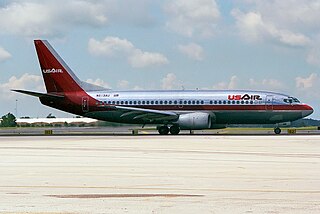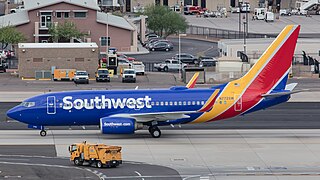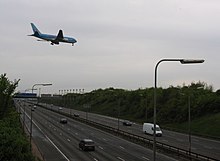
The 1985 Manchester Airport disaster occurred when British Airtours Flight 28M, an international passenger flight, was en-route from Manchester Airport to Corfu International Airport and caught fire on takeoff on 22 August, 1985. The accident resulted in 55 fatalities.

On the evening of February 1, 1991, USAir Flight 1493, a Boeing 737-300, collided with SkyWest Airlines Flight 5569, a Fairchild Swearingen Metroliner turboprop aircraft, upon landing at Los Angeles International Airport (LAX). As Flight 1493 was on final approach, the local controller was distracted, though air traffic was not heavy at LAX, by a series of abnormalities, including a misplaced flight progress strip and an aircraft that had inadvertently switched off the tower frequency. The SkyWest flight was told to taxi into takeoff position, while the USAir flight was landing on the same runway.

Pilot error generally refers to an accident in which an action or decision made by the pilot was the cause or a contributing factor that led to the accident, but also includes the pilot's failure to make a correct decision or take proper action. Errors are intentional actions that fail to achieve their intended outcomes. The Chicago Convention defines the term "accident" as "an occurrence associated with the operation of an aircraft [...] in which [...] a person is fatally or seriously injured [...] except when the injuries are [...] inflicted by other persons." Hence the definition of "pilot error" does not include deliberate crashing.

Helios Airways Flight 522 was a scheduled passenger flight from Larnaca, Cyprus, to Prague, Czech Republic, with a stopover in Athens, Greece. Shortly after take-off on 14 August 2005, air traffic control (ATC) lost contact with the aircraft operating the flight, named Olympia; it eventually crashed near Grammatiko, Greece, killing all 121 passengers and crew on board. It is the deadliest aviation accident in Greek history.

Thai Airways Flight 365 was a Thai Airways Company Boeing 737-2P5 with the registration number HS-TBC. On 31 August 1987, the plane crashed during a scheduled flight from Hat Yai International Airport to Phuket International Airport, killing all 83 people on board: 74 passengers and 9 crew. It was the deadliest aviation accident in Thailand at the time, before being surpassed four years later by the crash of Lauda Air Flight 004. Concerned by another aircraft in their vicinity, the crew reduced their approach speed while attempting to land, and failed to recover from an aerodynamic stall. In addition to pilot error, the air traffic controller was blamed for failing to keep Flight 365 and the other aircraft adequately separated.

Turkish Airlines Flight 5904 was a Boeing 737-400 on an international repositioning flight from Adana Şakirpaşa Airport in Adana, Turkey, to King Abdulaziz International Airport in Jeddah, Saudi Arabia, which crashed on 7 April 1999 in the vicinity of Ceyhan, Adana Province, in southern Turkey, some eight minutes after takeoff. The flight was on its way to Saudi Arabia to pick up pilgrims from Jeddah, and as such took off without any passengers on board. All six crew members were killed in the crash.

Garuda Indonesia Flight 200(GA200/GIA 200) was a scheduled domestic passenger flight of a Boeing 737-400 operated by Garuda Indonesia between Jakarta and Yogyakarta, Indonesia. The aircraft overran the runway, crashed into a rice field and burst into flames while landing at Adisucipto International Airport on 7 March 2007. Twenty passengers and one flight attendant were killed. Both pilots survived, and were fired shortly after the accident occurred. It was the fifth hull-loss of a Boeing 737 in Indonesia within less than six months and was the most recent accident with fatalities involving the airline.

Alliance Air Flight 7412 was a scheduled Indian domestic passenger flight from Calcutta to Delhi, operated by Indian regional airliner Alliance Air. On 17 July 2000, while on approach to its first stopover in Patna, the Boeing 737-2A8 operating the route nose-dived and crashed into a residential area in Patna, killing 60 people including 5 on the ground.
During the 1990s, a series of issues affecting the rudder of Boeing 737 passenger aircraft resulted in multiple incidents. In two separate accidents, pilots lost control of their aircraft due to a sudden and unexpected rudder movement, and the resulting crashes killed everyone on board, 157 people in total. Similar rudder issues led to a temporary loss of control on at least one other Boeing 737 flight before the cause of the problem was ultimately identified.

On June 9, 1996, while operating a passenger flight from Trenton, New Jersey to Richmond, Virginia, the crew of Eastwind Airlines Flight 517 temporarily lost control of their Boeing 737-200 because of a rudder malfunction. The crew were able to regain control and land the aircraft successfully. All 53 occupants on board the 737-200 survived with one flight attendant injured.

Aeroflot Flight 821 was a scheduled domestic passenger flight operated by Aeroflot-Nord in a service agreement with Aeroflot and as its subsidiary. On 14 September 2008, the aircraft operating the flight crashed on approach to Perm International Airport at 5:10 local time (UTC+06). All 82 passengers and six crew members were killed. Among the passengers who were killed was Russian Colonel General Gennady Troshev, an adviser to the President of Russia who had been the commander of the North Caucasus Military District during the Second Chechen War. A section of the Trans-Siberian Railway was damaged by the crash. Flight 821 is the deadliest accident involving a Boeing 737-500, surpassing the 1993 crash of Asiana Airlines Flight 733, and was the second-deadliest aviation incident in 2008, behind Spanair Flight 5022.

USAir Flight 427 was a scheduled flight from Chicago's O'Hare International Airport to Palm Beach International Airport, Florida, with a stopover at Pittsburgh International Airport. On Thursday, September 8, 1994, the Boeing 737 flying this route crashed in Hopewell Township, Pennsylvania while approaching Runway 28R at Pittsburgh, which was USAir's largest hub at the time.
Air France has been in operation since 1933. Its aircraft have been involved in a number of major accidents and incidents. The deadliest accident of the airline occurred on June 1, 2009, when Air France Flight 447, an Airbus A330-203, flying from Rio de Janeiro to Paris crashed into the Atlantic Ocean with 228 fatalities. A selected list of the most noteworthy of these events is given below.

UPS Airlines Flight 6 was a cargo flight operated by UPS Airlines. On September 3, 2010, the Boeing 747-400F flying the route between Dubai, United Arab Emirates, and Cologne, Germany, developed an in-flight fire, which caused the aircraft to crash, killing both crew members, the only people on board. It was the first fatal air crash for UPS Airlines. The crash prompted a re-evaluation of safety procedures protecting airliners from cockpit smoke.
In aeronautics, loss of control (LOC) is the unintended departure of an aircraft from controlled flight and is a significant factor in several aviation accidents worldwide. In 2015 it was the leading cause of general aviation accidents. Loss of control may be the result of mechanical failure, external disturbances, aircraft upset conditions, or inappropriate crew actions or responses.

Tatarstan Airlines Flight 363 was a scheduled domestic passenger flight, operated by Tatarstan Airlines on behalf of Ak Bars Aero, from Moscow to Kazan, Russia. On 17 November 2013, at 19:24 local time (UTC+4), the Boeing 737-500 crashed during an aborted landing at Kazan International Airport, killing all 44 passengers and 6 crew members on board, making it 2013's worst plane crash.

Southwest Airlines Flight 1380 was a Boeing 737-700 that experienced a contained engine failure in the left CFM International CFM56 engine after departing from New York–LaGuardia Airport en route to Dallas Love Field on April 17, 2018. The engine cowl was broken in the failure, and cowl fragments damaged the fuselage, shattering a cabin window and causing explosive depressurization of the aircraft. Other fragments caused damage to the wing. The crew carried out an emergency descent and diverted to Philadelphia International Airport. One passenger was partially ejected from the aircraft and sustained fatal injuries, while eight other passengers sustained minor injuries. The aircraft was substantially damaged.



















